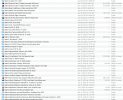I'm new to DJI drones and only bought my Mini 2 5 days ago. But after my first 3 flights recording in 1080p 30fps, I have realised that I will be racking up a lot of time and disk storage space over time with photos, videos and DJI flight logs etc. If you also add a phone screenshot video recording of the DJI Fly app, that's even more disk storage space to consume!
There's also disk space on the mobile phone device too from Fly app! How do folks handle that?
I am wondering how fellow DJI drone users are handling this? What's your workflow for dealing with photos, videos, DJI flight logs etc? How much disk space does your DJI drone usage consume?
Any tips and pointers are much appreciated
There's also disk space on the mobile phone device too from Fly app! How do folks handle that?
I am wondering how fellow DJI drone users are handling this? What's your workflow for dealing with photos, videos, DJI flight logs etc? How much disk space does your DJI drone usage consume?
Any tips and pointers are much appreciated












